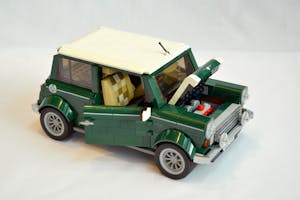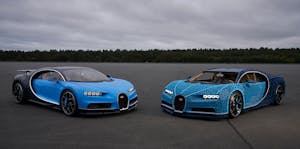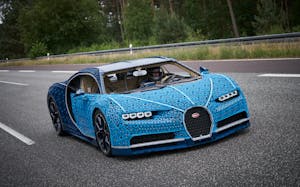Media | Articles
An insider’s guide to LEGO cars, from bite-sized to life-sized
Whenever LEGO announces a new car model—and the company has been revealing some real gems lately—the opinions start flowing. Why this car? Why is it so big—or so small? Did the designers overlook any details that we can nitpick? What’s up with that price? Is LEGO really the world’s largest manufacturer of tires? (Yes.)
Not all LEGO car models are created the same; in fact, they’re sorted into several distinct product lines, each with a different approach, building experience, and target audience. For the purposes of this buyer’s guide to LEGO cars, we’re focusing on sets featuring replicas of real production vehicles. How cars are chosen for the LEGO treatment, how they’re designed, and how to choose a model that meets your (or your kid’s) expectations.
(In the interest of full disclosure, I should mention that I’ve worked several jobs at LEGO myself, and that my family also has ties to the firm which go even deeper than the average two-by-two brick underfoot on Christmas morning.)
The good news is that LEGO is in its best era of car models yet, and if you find car culture inaccessible in our time of social distancing, a few hours of play might be just what you need.
LEGO product lines
First, we’ll take a look at LEGO’s current product lines that feature car and bike replicas, ascending in price and complexity. LEGO put us in touch with Louise Bontoft, the Senior Creative Director for the Adults, Preschool and Create products at LEGO. Bontoft is based at LEGO’s global headquarters in Billund, Denmark.
Marketplace
Buy and sell classics with confidence
The company’s product lines have become much more cohesive in later years, and the level of detail has improved tremendously. Whenever a new LEGO car is teased, without fail, you’ll find Internet denizens who will complain that a Speed Champion set “isn’t detailed enough”… but they will then turn around and complain that a Technic set with an intricate working drivetrain costs upwards of $300. In truth, each set is a considered compromise between cost and detail—and it’s all in the part count. Smaller sets are designed to be accessible for kids, in terms of size and pricing. The level of detail is moderate, due to the relative lack of complexity. Mid-range and large sets feature much more detail, but as the part count increases (necessary for finely detailed models), the price does, as well.

“A large part of our portfolio consists of products designed to inspire adult builders whilst catering to differing levels of building experience,” said Bontoft. “A difference between the franchises also relates to the level of challenge we provide, both on size and scale of the models, but also in the way the models are built. Some may enjoy collecting several smaller cars from e.g. Speed Champions, others may cherish the many hours and focus you need to put into building an advanced gearbox in one of the 1:8 scale Technic supercars.”
What we really wanted to know is how specific vehicles are chosen for specific types of models — for example, why the MINI Cooper is a Creator model, but a Porsche is a Technic model, and how the Audi R8 became a Speed Champions model. According to Bontoft, LEGO chooses models to appeal to a wide range of car enthusiasts, and it’s an ongoing challenge to understand and anticipate what consumers want.
“Some vehicles in Creator Expert tap into nostalgic classic vehicles, whilst other lines including Technic appeal to modern petrol heads who appreciate race and luxury cars, trucks and machines that both look and function like the real vehicles,” said Bontoft. “By that we aim to cater for different needs and passions across our assortment, serving as many different options as possible to the car enthusiasts.”
Speed Champions

Age 7+, MSRP $14.99+
The Speed Champions line is the current point of entry for LEGO cars. The lowest-priced sets in the line, as of this writing, include Chevrolet Camaro ZL1 Race Car, McLaren Senna, and Ferrari F40 Competizione. These sets generally include about 200 pieces and are roughly scaled in proportion with LEGO’s minifigures; to that end, some Speed Champions sets feature a LEGO minifigure dressed in race gear. On the higher end, at about $50, enthusiasts can grab a pair of MINI Coopers, 1967 Mini Cooper S Rally and 2018 MINI John Cooper Works Buggy, or a pair of Lambos, Lamborghini Urus ST-X & Lamborghini Huracán Super Trofeo EVO.
Creator/Creator Expert

Age 16+, MSRP $89.99+
Though miniature versions of some iconic LEGO models, such as the MINI Cooper and Volkswagen Camper Van, have appeared under the basic Creator line, classic LEGO vehicles are most often found labeled as Creator Expert. Creator Expert is marketed toward experienced builders and adults, and is a great choice for project for parents to share with their kids. Recent additions to the Creator Expert vehicle lineup include the Harley-Davidson Fat Boy (1023 pieces, $99.99) and the James Bond Aston Martin DB5 (1295 pieces, $149.99).
Technic

Age 9+, MSRP $49.99+
Some LEGO designers have worked on the Technic line for more than 20 years, and according to Bontoft, it takes a LEGO designer “many years to train to the expert level needed.” The Bugatti Chiron (3599 pieces, $349.99), with its working gearbox, is one example of a Technic model that required the most experienced designers on the team. The level of detail in a Technic set means it’ll hit the three-figure mark more often than not, but recent introductions like the Ducati Panigale V4 R (646 pieces, $69.99) and Dom’s Dodge Charger from “Fast & Furious” (1077 pieces, $99.99) help broaden the line’s appeal. At the high end, there’s the Lamborghini Sián FKP 37 (3696 pieces, $379.99) which boasts a V12 engine with moving pistons and is recommended for ages 18 and up.
Older product lines
Cars feature prominently in older LEGO lines such as Ideas, Hobby Set, Racers (sort of a precursor to the current Speed Champions line), System, and a variety of sets categorized as “promotional” (McDonald’s Happy Meal toys and the like).
System may be the most interesting of the group, since it’s the least like LEGO as we know it. According to Brickset, a crowdsourced database of LEGO sets, System cars span a decade, about 60 sets produced in the 1950s and ‘60s. They’re notable because they’re intended to be complements of a city or town scene, like a diecast, rather than a car that is built by the user. The System cars are 1:87 scale and focus on European models. There are a number of Volkswagens, including numerous Beetles, Vans, and Pickups. Mercedes and Opel are also well-represented, as is the Ford Taunus, which reappears in several different years of the System line. There were a handful of multi-car value kits, and a few in which the car accompanied a garage for the user to build. These LEGO cars exist today in such small numbers that they don’t even have estimated values on the collector’s market; Brickset database users self-report ownership of these cars in the low dozens.
Racers, which was popular during the 2000s, consisted mostly of generic performance car designs but also incorporated a bunch of Ferrari F1s and a couple of random Lamborghini models. This line included everything from 1:9 scale Technic models to small polybags, the kind of impulse buy set you’d see on a store endcap or in a checkout line for a few bucks. Though Racers was kind of a catch-all product line for cars, with less differentiation among different types of models than current product lines, it’s fair to speculate that its popularity helped justify the wide variety of product types available today.
(Editor’s note: Mrs. Threewitt is too young to remember this, but I cut my LEGO-motoring teeth on the LEGO Expert Builder Auto Chassis 853, which acquainted me, and many others, with the workings of a two-speed transmission and a rudimentary piston engine — Jack Baruth)
Collaboration and design process

LEGO collectors have probably noticed that some cars have popped up frequently over the decades. Volkswagens are a favorite, with multiple appearances of the Beetle and T1 Camper. Numerous Ferrari models have been rendered in LEGO across different product lines. There are also multiple LEGO models of the Bugatti Chiron, Ford Mustang, and MINI Cooper, among others. These cars have iconic designs and have earned the hearts of car fans around the world, making them ideal for the LEGO treatment. Furthermore, these automakers are experienced in successful collaborations. Here’s how the LEGO process works.
According to Bontoft, the LEGO team starts by reviewing partnership opportunities — that is, automakers willing to collaborate with LEGO and the vehicles that would make good candidates. Then, the team analyzes data that helps LEGO figure out which models might resonate best with buyers.
“Our adult vehicle design teams then embark on a highly creative phase exploring each partner opportunity to see if it holds the potential to make an engaging and fun build that adults will take pride in showcasing,” said Bontoft. “We really want to give our consumers the best possible experience, so we always aim to base our decisions on insights and data directly from the consumers. So once we have narrowed down the ideas, we also set up tests with our core consumers to get some direct feedback on our ideas.”

In short, cars for LEGO sets are chosen based on the automaker’s willingness to collaborate, how the car’s recognizability will translate into brick form, if buyers will feel inspired by the building process and enjoy owning the finished product, and how well the model is likely to sell around the world.
Authenticity is also a priority for the automakers and for LEGO. That’s what sets these models apart from the more generic cars in the LEGO lineup—not that there’s anything wrong with those—and from other brands of toy cars. Though LEGO’s talented designers are experts in the art of sculpting every imaginable shape from plastic bricks, they aren’t vehicle designers or engineers—and sometimes a LEGO model in progress needs a little guidance from the car’s makers to get it just right.
“To be able to get our vehicles as authentic as possible we need to have very strong collaboration with our partners. So we communicate a lot along the development process, both to understand the design ethos of our partners, but also to get a tangible impression of the real life vehicle we are trying to re-create in LEGO bricks,” explained Bontoft. “Sometimes we also co-create certain models, shapes, functions or other parts of the experience together with our partners to really get as close to the real thing as possible. They are the experts of their creation and we need to get that under our skin to be able to translate it in to the right LEGO experience for our consumers.”
Trailer queens

No guide to LEGO cars would be complete without mentioning the life-size models you may have seen at auto shows or shopping malls. If you’ve seen one of these behemoths in the United States, there’s a good chance it came from LEGO’s model shop at the company’s North American headquarters in Enfield, Connecticut. Master Builder Chris Steininger (whose father, Dan, was my boss when I worked in that very shop) provided insight into the process via email.
He explained that most retail LEGO sets are designed in Denmark, while the United States-based Master Builders specialize in large-scale models. All life-size models, including car replicas, follow the same process, which, according to Steininger, looks something like this: A kickoff meeting yields a napkin sketch, which is then replicated into 3D mesh via computer by a LEGO designer or Master Builder. Another computer program called LEGO Brick Builder converts the 3D design to LEGO bricks, which is fine-tuned to achieve the desired look.
Large-scale models are usually built around a steel frame for strength and durability, but are otherwise hollow—a solid model would consume far too much brick, take too much time to build, and would be extremely heavy. The models are built by hand, one LEGO element at a time, and are glued in place with a special glue that fuses the bricks together. Some even move, like a lowrider recently completed in Enfield, which incorporated the chassis of a golf cart to enable drivability.
“When doing models like this, a lot of engineering needs to be done to get the LEGO model and golf cart to become one, including a lot of steel fabrication to the golf cart so the LEGO bricks can be attached,” said Steininger. “My favorite part of building the lowrider was integrating the working lights sound system and airbag suspension into the build.”
After a life-size LEGO car stars in its commercial or completes the auto show circuit, it’ll usually be put on display where it can continue to impress car fans and LEGO fans alike.
“Typically, these models live a long life after their initial engagement, sometimes in LEGO stores or at other LEGO events around the world,” said Steininger.
You probably don’t have space in your garage for a full-size LEGO model—a true trailer queen—nor will you be able to get your hands on one, no matter how dedicated or resourceful a collector you are. You can almost certainly spare some shelf or desk space, though, whether your budget and taste are best suited to a $15 Porsche or $350 Bugatti. Collecting LEGO cars is easy to get into and hard to quit, and yields a sense of satisfaction that comes close to the real thing.















